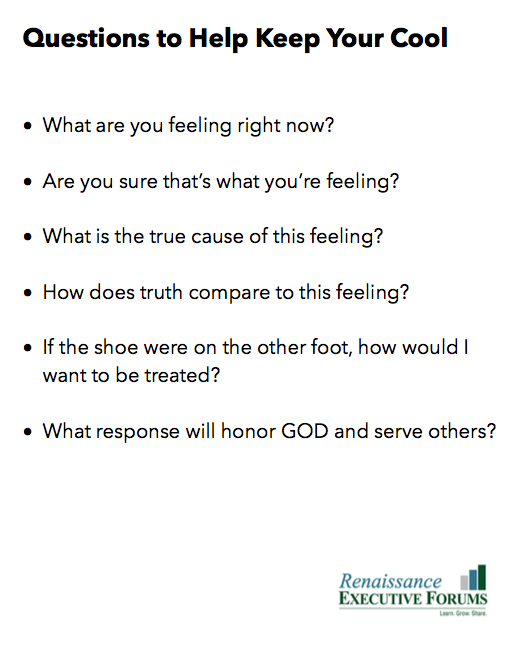“All the power in the world lies between stimulus and response.”
My Mom always told me that no one can make you mad – you have to choose to be mad. You cannot control what people do but you CAN control how you respond. This week I spent time with a few of my executive coaching clients to help them process issues. It’s amazing to me how fast things can go sideways in the workplace and crush working relationships. People get so emotionally involved that they lose sight of the real issue. The fact that I’m outside of the issues allows me to see things in a neutral manner and help them get back on track.
People don’t see your intentions, they see your actions.
I’ve been reading a book on Emotional Intelligence and this has led me to think about my emotions to see how my actions live out what I truly feel. I do two emotions really well; Happy and Angry. I’ve come to realize that in the case of anger, this is usually some other emotion I don’t like dealing with so I move to anger. These are emotions like embarrassment, selfishness, pride, fear and these usually come out as anger that is too often directed at people I really care about. I created this process flow below to help me see where I may be getting off track and see if this makes sense to you too.
The last item may not matter to you but it does to me. After I get clarity on it all, I compare this to what GOD has called me to be like. Whatever drives your underlying decision process should be the final factor in your dealing with emotions.
How to Process Challenges
We all have challenges we face each day and here are some things I’ve learned by working with business owners and CEOs here in DFW that I know will help you as you lead others.
Check your emotions
Are you carrying pent-up frustrations from previous situations and dumping them into this situation. Take a minute to see if your emotions are adding anything to the perspective and factor that out. Use my flow chart above, use some EQ and the time to get clarity.
Give it a few minutes to cool down
I’ve seen great value come by people taking a few minutes apart and coming back together with a cooler head. Set a short period of time and agree not to do anything about this issue until you meet to resolve it. During that time get your thought together and be ready work with others to find the solution.
Be slow to speak and quick to listen
Your team will focus more on HOW you respond to something than the actual issue. Repeat what you think you are hearing others say so you are sure to understand them. Be okay that they see it differently than you do and show them respect by the way you respond.
Q-storm the issue
We are quick to pull the team together to brainstorm a response when we should first be “Q-storming” to ask all the questions possible and get to the heart of the issue. Work to use open-ended questions to draw out deeper responses and don’t offer any suggestions in the form of a question. If you spend more time finding the cause to the issue you are sure to find a better solution.
Focus on the future
Address the issue and move on. Work to be a Peace Maker rather than a Rights Defender. Yes that issue happened, and yes you may be in the right, but find out what went wrong, make a plan to avoid it, and move on to work together.
Most of you already know this but sometimes we are too close to the situation to see it clearly and that is why my clients have me to bounce off thoughts and plans. Let me know if you need any more explanation on these and I hope this helps.
Robert Hunt
